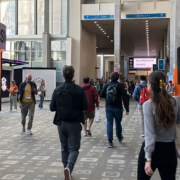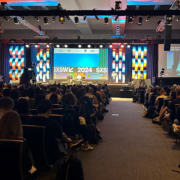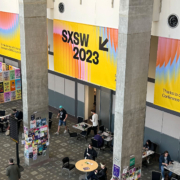- SXSW 2024: The Transition Generation - 15. March 2024
- SXSW 2024: Addressing the Consumers of Tomorrow - 13. March 2024
- SXSW 2024: Monday’s Tech Roundup - 12. March 2024
- Culture Media and Hype Cycles: The future of marketing? - 11. March 2024
- South by Southwest 2024: Embracing the Unknown - 11. March 2024
- Meta “Threads” – short trend or serious threat to Twitter? - 31. July 2023
- SXSW 2023 Day 5: Brand Science - 15. March 2023
Duality is a major theme at SXSW, down to its programming, speakers and organisation. Tech and business meet entertainment and arts: A-List celebrities and highly specialized niche experts. A massive 10 day conference planned for over a year by a small team at SXSW, but only made possible by the contributions of hundreds of volunteers over the course of the actual event. Duality, and with it the inevitable mixing and mingling of different ideas and processes and cultures, let’s us make the most interesting observations at the convergence points in between.
The Internet as we know is gone – we just don’t see it yet
We focused our 2nd day at SXSW 2023 on the heavy hitters in the speaker line-up, starting with CEO and founder of the Future Today Institute and SXSW legend Amy Webb launching the 2023 edition of the Emerging Tech Trends Report. Queuing up shortly after 8am for the 10am session turned out to be a good decision, as the room was absolutely packed and many attendants didn’t manage to get in at all.
The talk itself focused on roughly 35 out of the 666 (!) trends from the latest set of reports and – as mentioned in the intro – the most interesting things will happen at the convergence points between different trend clusters, two of which Amy Webb talked about in detail.
Cluster one, the convergence between web3, cloud computing and – you guessed it – artificial intelligence will lead to a major reshaping of business and society. Or as Amy Webb stated: The Internet as we know is gone. The question we have to ask ourselves is: What if you don’t search the internet, but the internet searches you? With the proliferation of AI and Large Language Models (LLM) combined with Reinforcement Learning from Human Feedback (RHLF), everything around us becomes information that is ready to be processed and used to train AI models – with highly capable generalist AIs on the horizon that will shadow anything we see today.
The infrastructure to power these AIs can realistically only be provided by a couple of big tech companies, further solidifying the existing monopolies in digital infrastructure, late and lacking regulation and very little ethics involved, if these companies are left to regulate themselves.
Amy Webb drew two possible scenarios for the year 2033 – an optimistic one, with people centric AI and data management centred on the common good in a transparent and decentralized setup with opt-in data sharing where this new infrastructure works for the user and provides real and tangible benefits. And the catastrophic one, where our digital footprints are constantly scraped into models, leading to aggressive curation and recommendation instead of true user choice. We end up surrounded by information, but can’t get the actual things we want. Chances of the latter happening according to Webb: 80 %.
The second cluster, the convergence between AI, the Metaverse, bio-engineering and healthcare focused on assistive computing of the future where generative AI and the industrial metaverse act as invisible and ubiquitous tools leading to major improvements not only in medicine but in almost any profession. The danger: creating a new digital divide for those who weren’t trained to use these tools early on. The optimistic scenario for 2038: we invest in education and upskilling and these new tools positively transform the workforce. The catastrophic one: assistive tools are mere ways to increase revenue, we face a massive digital divide and let the AI cause actual harm due to inherent biases and a lack of human reinforcement. Chances: 50:50.
The complete reports and additional goodies from Amy Webb’s session can be downloaded here.
The only future we can make is one we are able to imagine
The next session had a much less gloomy outlook on the future – even though it focused on similar themes. Rohit Bhargava, SXSW regular and author of the highly successful Non-Obvious Trends newsletter and book series teamed up with trend forecaster Henry Coutinho-Mason to speak about technology, that might have looked like science fiction just a few years ago, but will feel totally normal to us soon.
Metabolic monitoring for better understanding of personal diets, virtual companions that can have positive impacts on our mental wellbeing, synthetic food, that might require a completely new way of brand storytelling, that for the longest time focused on championing “natural”, immersive entertainment, and augmented creativity supported by generative AI. It was a refreshing interpretation of what technology can do for us, if we think about it positively. The fact that the talk happened right after Amy Webb’s session just further reinforces the theme of duality at a place like SXSW and shows that both these ideas can co-exist – it is up to us, what we take away.
Fixing the Complexity Crisis
The afternoon started with a session by Nick Law, Global Lead for Design and Creative Tech at Accenture Song. You might think I’m starting to make things up, but duality was a major topic in this talk as well. Law spoke about the necessary structure in organisations to enable great creative work in an increasingly complex environment. The combination of copywriting and art direction, brand and performance, design and storytelling – and the ideal connections between people from different fields to create truly outstanding work what neither party could have done on their own. It was a convincing call to invest the time and effort to transform the organizations we are part of, illustrated with many examples from the history of advertising down to his own illustrious career at R/GA, Apple and Accenture.
Artificial Intimacy
What better way to end the day than with a session by another prolific SXSW speaker – renowned psychotherapist, podcast host and author Esther Perel asked important questions: to what extent is artificial intelligence a conduit to artificial intimacy? What effects do the growing popularity of AI therapy bots have on mental health? How are our relationships affected by the proliferation of hyper-connectivity and the performance metrics we apply to our digital self expression? For Perel the answer is clear – human relations are way too complex and ambiguous for AI systems to grasp and our hyper-connected digital lives prevent us from being truly present in our real relationships.
Random observations from day 2:
- Instead of exporting SXSW to Australia, the organizers should think about opening a branch in Brazil – then again it feels like half the Brazilian tech & marketing crowd is already in Austin anyway.
- Did I mention: the lines are back? SXSW has really perfected the art of queue management and every year new I get introduced to new creative ways of lining up. And all of it is surprisingly analog, considering the digital and techy nature of many of the sessions.
- I want to hang out with the person in charge of decorating in the hallways of the downtown Hilton. Keep celebrating the tacky 90s vibes!







